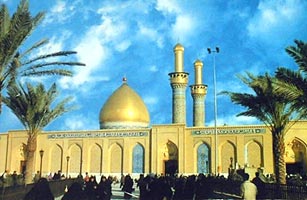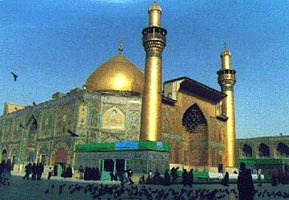Kerbala:

(Imam al Hussain shrine), Al Abbas shrine. It lies 102
kms, away from Baghdad, 78 kms away from Najaf and 45 kms, away from
Hilla. It witnessed great events which left their mark on Islamic
history – mainly the tragic battle of Tuff, in which were martyred Immam
Hussain Bin Ali and his brother Abbas together with many others, who are
buried in their two great shrines in the city. Kerbala, though
practically on the edge of the desert, lies amidst fruitful orchards
thick with greenery and palm trees. The famed Ukhadher castle is 50 kms
away from the city.
Najaf:
 The shrine of Imam Ali Bin Abi Talib. 60 kms to the south of
Hilla is the holy city of Najaf, where lies the shrine of Imam Ali Bin
Abi Talib with its resplendent golden dome and minarets. Great
quantities of priceless objects, gifts of potentates and sultans, are
treasured in the mosque. One of Islam’s most important seats of
religious instruction, Najaf has many schools where grammar, theology,
history and literature are taught. Thousands of pilgrims visit the city
annually.
The shrine of Imam Ali Bin Abi Talib. 60 kms to the south of
Hilla is the holy city of Najaf, where lies the shrine of Imam Ali Bin
Abi Talib with its resplendent golden dome and minarets. Great
quantities of priceless objects, gifts of potentates and sultans, are
treasured in the mosque. One of Islam’s most important seats of
religious instruction, Najaf has many schools where grammar, theology,
history and literature are taught. Thousands of pilgrims visit the city
annually.
Kufa:
Muslim bin aqeel tomb. An important Islamic town of early
Arab history, Kufa was the first Arab capital proper, founded by Saad
Bin Abi Waqqas in A.D 618 and adopted by Ali Bin Abi Talib as the center
of his caliphate. It had four sectors with the house of the caliphate
and the mosque occupying the central space. Its main mosque with the
golden dome holds the tombs of Muslim Bin Aqeel and Hani Bin Arwa. It
stands on the site of the original first mosque which excavations have
shown to have been square in dimensions. It has 28 semi circular towers.
Next to the mosque the house of Imam Ali Bin Abi Talib is reconstructed
house of the caliphate (Dar Al-Imara) which has an outer square wall,
each side 170 meters long, 4 meters thick, with 6 semi circular towers
supporting each side, with the exception of the northern side which has
only two towers. The inner building is also square-shaped, 110 meters to
every side with walls two meters thick, and similarly supported by semi
circular towers. It has a number of halls, “ewans” and courtyards.
Basrah:
It was the starting point of Sinbad the sailor’s
adventurous voyages to the world. When you see it today you will be
reminded of the commercial importance it has enjoyed for centuries:
endless ships shuttle back and foth on Shatt Al Arab, on which it is
built. It is Iraq’s port on the Arabian gulf. All around it are millions
of palm trees whose delicious dates belong, literally, to hundreds of
categories.
Basrah was found by Utba Bin Ghazwan on orders from caliph Omar Bin Al
Khattab in A.D 637 and has been a major Islamic city ever since. There
are so many places of archaeological interest as well as religious
importance, such as Imam Ali’s mosque built in the year 14 after Hijra,
the shrines of Al-Zubair Bin Al awam, Talha bin Ubaidillah, Al hassan Al
basri, ibn Serene and Ibn Al Jawzi.

